When Is The Best Time To Send Marketing Emails?
The question above is probably why you are at this article, searching for an answer through several different posts. If you have searched for a while, many sources will provide the same solution: It depends. But that is not so helpful for you, is it?
You see, if you want your marketing emails to have the best results, you need to know the right time to send them out. If your emails go out at the wrong time, the opening rate could plummet. The perfect timing can have a huge impact on your campaign’s effectiveness. From the higher open rate, you can create a snowball effect of more subscribers, more traffic, and even more conversions.
Your business can get all that just by setting your alarm at the right moment to send out emails. Today, let’s learn the best time to send marketing emails and how to automate the timing so you can make the biggest splash. And, don’t worry, you won’t have to wake up at 3am to do it!
Why does email timing matter?

The perfect time to send emails is the time that works for your target audience. When we say ‘timing’, the first thing to pop in mind is about the specific day and time, but that is not the only factor to consider. Every email list has a different set of people with all kinds of habits.
There are tons of studies from many sources on email timing, but many posts just conclude that it is best to depend on specific situations because there are so many contradictions. Therefore, your best email sending time may not be on Tuesday at 8am, like some research suggests.
“But you just said that is not so helpful?” I know you are screaming this out, I get it, and I don’t want to give you that kind of answer too. I will provide you with an excellent place to start, with tools to test and tweak your sending time to further perfect it. You are looking to achieve bit by bit increase in the following metrics with each new timing setting:
- Improved email open rates
- Increase in brand name search
- More website traffic from emails
- More offline inquiries
- Better promotion sign up rate
As with any other digital marketing tactic, email timing tactics need time to start working. Once you find a suitable time frame that works with your audience segments, you can increase your chances of boosting your bottom line and improving your engagement metrics.
And that is exactly why email timing matters to your business.
How to measure the performance of email timing?

There is a lot of data out there on email timing with different answers, but you should measure your success on your own audience for the best effect. Here are the most important metrics to see the performance of email timing.
- Open rate: The percentage of the subscribers that opened your email campaign. Emails with a great open rate not only have the right timing, but also good subject lines and optimized preview text.
- Click-through rate: The number of people who open a link or image link in your emails. This is often smaller than the number of emails opened since it requires further action. Many would open your emails and don’t engage further, you shouldn’t take this as a surprise.
- Click-to-open rate: Comparing the number of people that opened your emails and the number of people that clicked on any links. This metric helps identify which information your subscribers find relevant. The click-to-open rate is calculated by dividing the click-through rate by the open rate and multiplying it by 100%. For example: If your email campaign has 100 clicks and 300 opens, your click-to-open rate is 33%.
Through each email campaign with different timing, you will learn the campaign’s performance through these metrics. A good email app will help you analyze the recipients behaviors and these metrics, leading to better timing in the future.
The best times to send emails (backed by science)
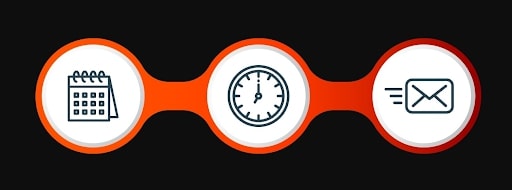
When most marketers consider how time relates to their email marketing effort, they quickly focus on what is the best hour to send their campaign. While deploying emails at the wrong time can certainly lead to lower engagement rates, many other variables should also be considered, such as audience demographics, price of the service, user milestones, and more.
Read on to have a deeper awareness of the issue so you can use the ‘timing factor’ to your advantage and set up successful email campaigns.
Best days to send emails
By looking at many studies online analyzing over 4 billion emails, I gathered information on the best time to send to email addresses in their local time zones. The surprising fact is that there is very little difference in engagement between any of the weekdays, from Monday to Friday. Weekends are not so great to send emails, with Sunday being slightly better than Saturday.
The graphs show that Tuesday has the highest open rate and click-through rates and is the most popular day to send emails. Weekends have the worst performance with the lowest open rate. According to most researches, open and click rates decline toward the weekends.
Not every study I found had a visual presentation of their data, but you will find it interesting that there are some similarities among the graphs that were present. Most activities happen in the middle of the week with only minor outliers.
That said, what we can make out of all this data is:
- Tuesday is hands down the best day to send emails, according to most of the data from research.
- Thursday is a good option for the second day in an email sequence if you want to send two emails a week.
- Wednesday often comes in second place as the day with high engagement rates.
However, these days are only to consult, and there is no consensus on the week’s exact day that you have to send emails. The day of the week doesn’t make that much difference in terms of open and click rates. There will always be different companies’ cases, which just don’t behave the way other email lists do.
For example, Workaholics are most likely to check their promotion emails over the weekend, over a cup of coffee in the morning, so overnight emails may have a better chance of getting opened. A busy parent may not check the inbox before Friday night, at which time seeing four of your messages may not be too exciting.
That is why it is really important to do your own research using data from your own list. You may find that your best days to send emails are entirely different from the study. I will show you how to figure out all that later.
Best time to send emails
Based on multiple research, if you have an email campaign for sale or promotion, try sending them during the time your target audience takes their lunch, simply because they are more likely to check their inboxes on the phones during this time. That may explain why late-morning send times are popular among marketers.
When examining the flow of the days, the timing from the research even makes more sense. For example: sending emails during the night is a great way to capture those who check emails first thing in the morning, before they even get out of bed. In terms of orders per campaign, 4pm turns out to be the best. This may be because recipients have more time to make purchases during that almost-out-of-work time of the day.
While many data shows various results, here is the conclusion to prioritize sending time:
- 10am is considered the best time to send emails among the late-morning send times, with 11am being another good option.
- 8pm - midnight emails generally receive more opens and click-through later in the evening. This is likely due to people who check their emails before bed.
- 2pm can be the time for a successful campaign too, since your emails arrive later in the day, when people are checking out of work or looking for a distraction.
- 6am is a time that makes a lot of sense since many people begin the day by checking emails even before they stand up. Good morning to them with a good email.
A big takeaway is to choose the time zone that the majority of your audience lives in. If you are in the US, Eastern Time is likely the time zone that covers 50% of the population. If you are a local business and want to send to customers nearby, send emails at those times in your own time zone.
Still, keep in mind that the main driver of engagement for your emails is you: the content you send, the industry you are in, and the list you’ve gathered. Use these times as a starting point for sending your campaigns and change when you need to.
How to find the best timing for your email list?
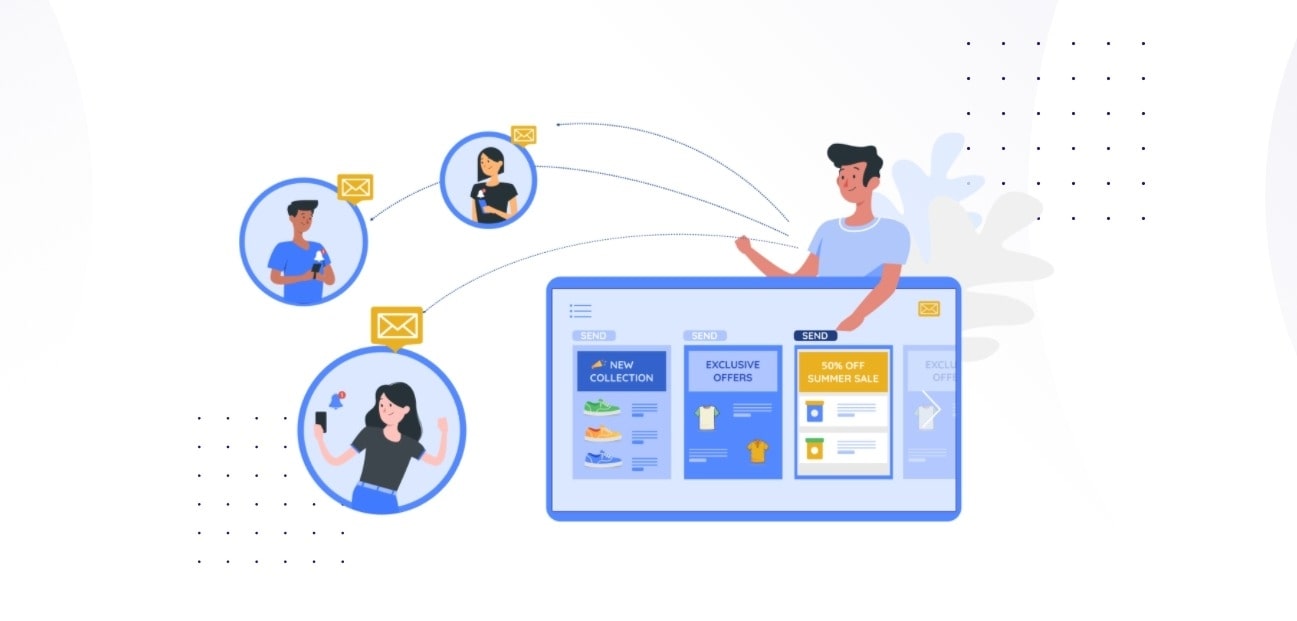
Now that you know what days and times work for the majority of email marketers across the world, you have a good knowledge to start. So first, try scheduling your emails to get sent in the morning on weekdays (Tuesdays at 10am, for example).
After your campaigns have gathered a significant amount of data, take a look at the open rates. A good open rate can vary depending on the industry, but the average email open rate across all industries is 21.33% in 2019. If you see that you need to improve your open rates, that is great! It is always better with rooms for improvement.
Start testing your email send times to see which time has the best performance for the goals your campaigns are trying to reach.
For example: If your campaign’s goal is to make more sales, then focus on the email conversion rates to see which times bring the most sales. For engagement with a newsletter campaign, the times can be very different. Remember to always test only one single variable at a time. You will need to send the exact same email with the same subject line to A/B test your send times.
But, how do you decide that time to experiment? It’s easy:
Write down everything that you have information on about your subscribers and their relationship with you. What jobs do they have for a living? What is a day in their normal life like? Also, what is your email’s content, and when are your subscribers more likely to be thinking about your content? The key is to find out when and how your subscribers are most likely to engage with your brand’s emails.
If your subscribers also follow your company on social media, that’s a perfect opportunity to see when they are often active online. You can see when your Facebook followers have the most activities with the engagement report from Facebook Business - which shows response rates by weekdays and highlights the highest-performing day. You can also see the response rates by different times of day, also with the highest-performing time.
From this, you can identify when your Facebook followers are active on your page. For example, if yourFacebook fans are the most engaged on Tuesdays from 8 am to 2 pm, with the highest engagement happening at 1 pm, you know these are great times to test sending out your emails!
Here is a simple checklist of days and times that you can test sending your emails, the data gathered from these campaigns will help you adjust the timing for future campaigns:
- Tuesdays at 10am
- Wednesdays at 2pm
- Thursdays at 8pm
- Tuesdays at 6am
- Thursdays at 10am
- Wednesdays at 8pm
How to automate email’s send timing?
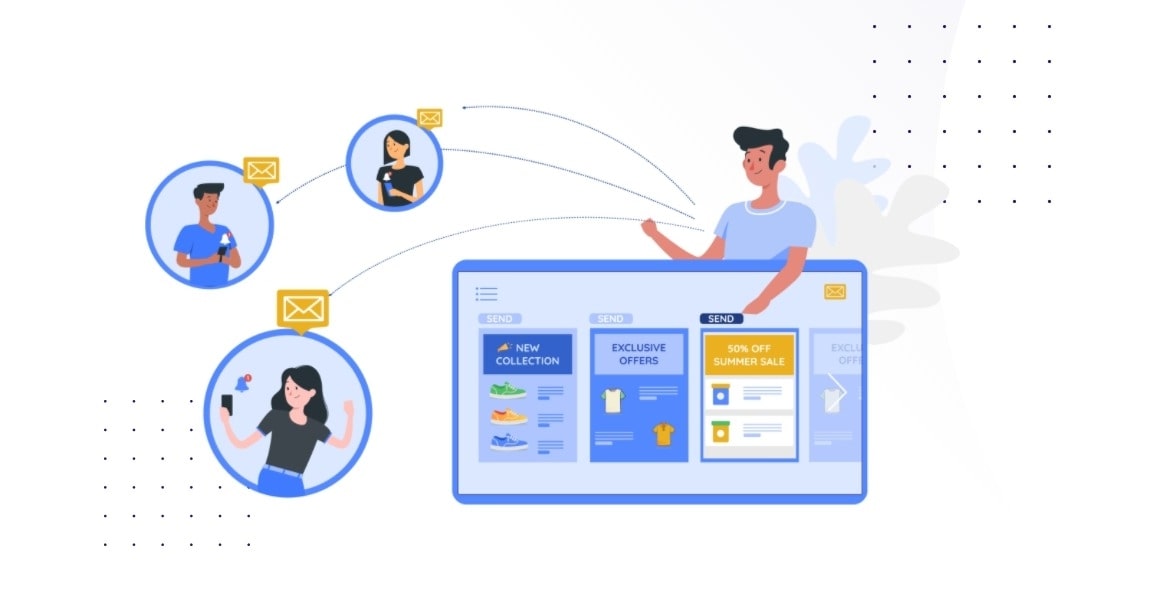
It would be really time consuming to manually create and send your email campaigns to the list on the specific day and date. With an email automation app, you set up the content and time once, and when the trigger time comes, your emails will send out without any additional effort on your part. Score!
Gmail can help you automate the timing, but savvy companies always use email apps that can automatically send emails based on the user’s actions. Why? Because the apps can help you create timely, personalized, and hyper-relevant campaigns to the reader. As a result, these emails get opened more frequently and drive more traffic to the business.
Do you want an easy email app that helps automate your emails’ send timing? Then AVADA Email Marketing app is here.
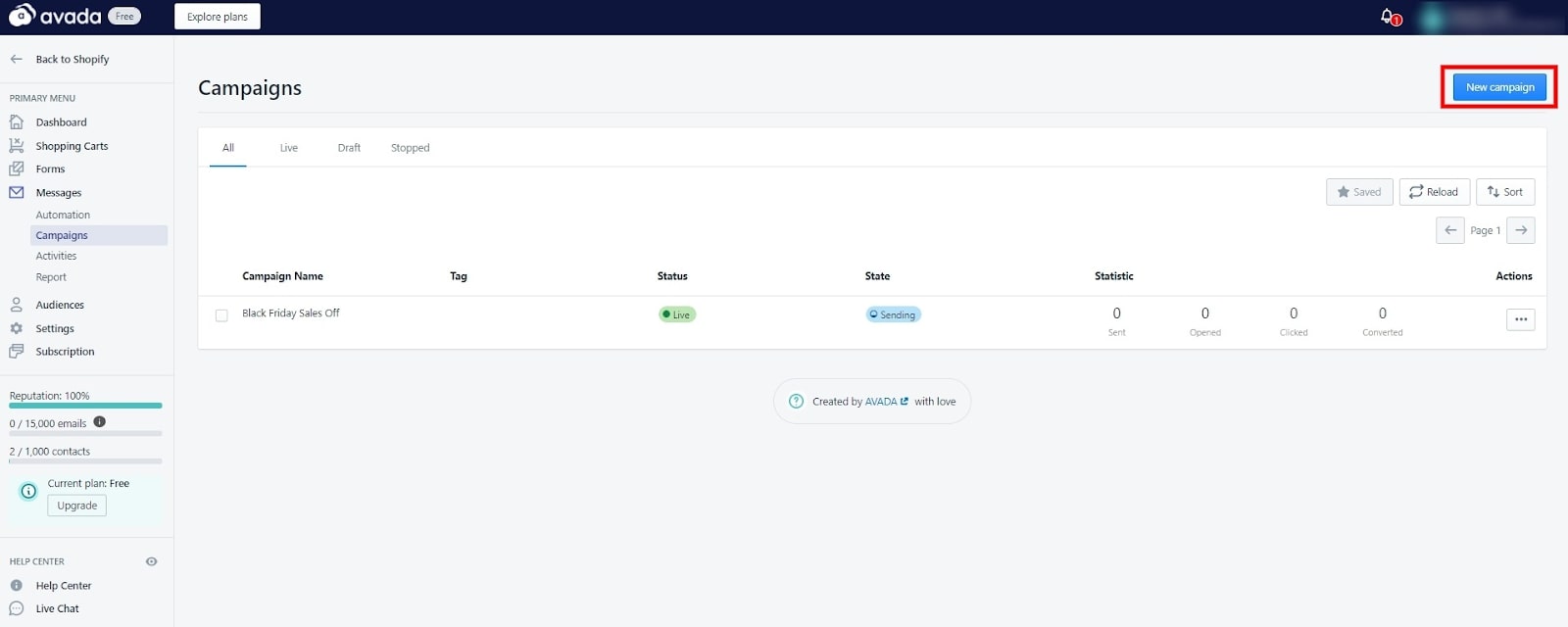
You can access the app through the link above, and the app is free to start using now. Once installed, you will be taken to a dashboard like this. Head to Messages -> Campaigns to start making an automated email campaign. Click on ‘New Campaign’.
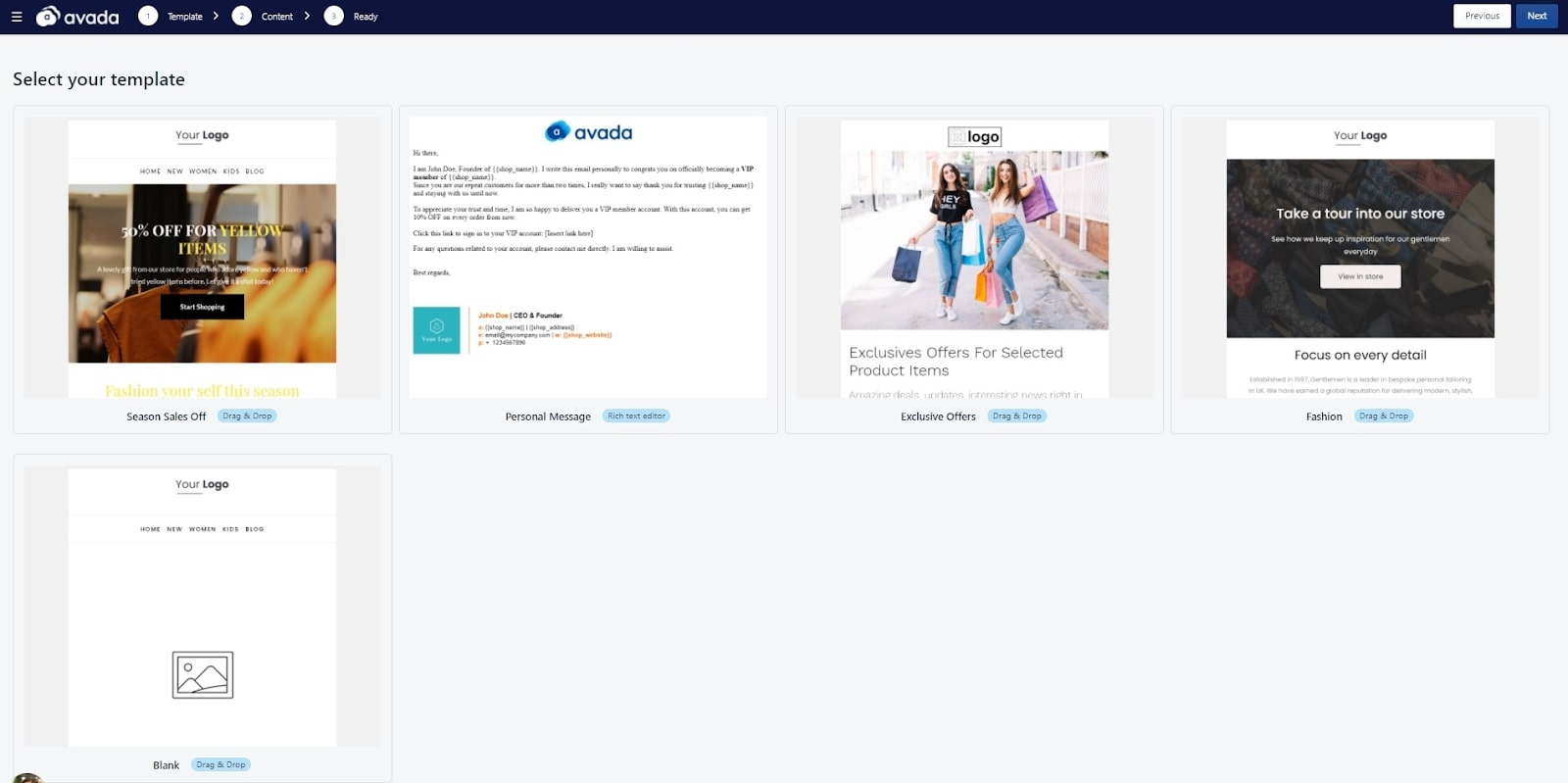
At the first step of creating an email campaign, you can select the email templates for your emails. There are already some premade templates for you to use, but you can select a blank template to customize as you wish or edit a template. Once you are done, click on ‘Next’. For example, let’s say you want to send an exclusive offer email to subscribers on Tuesday at 10am.
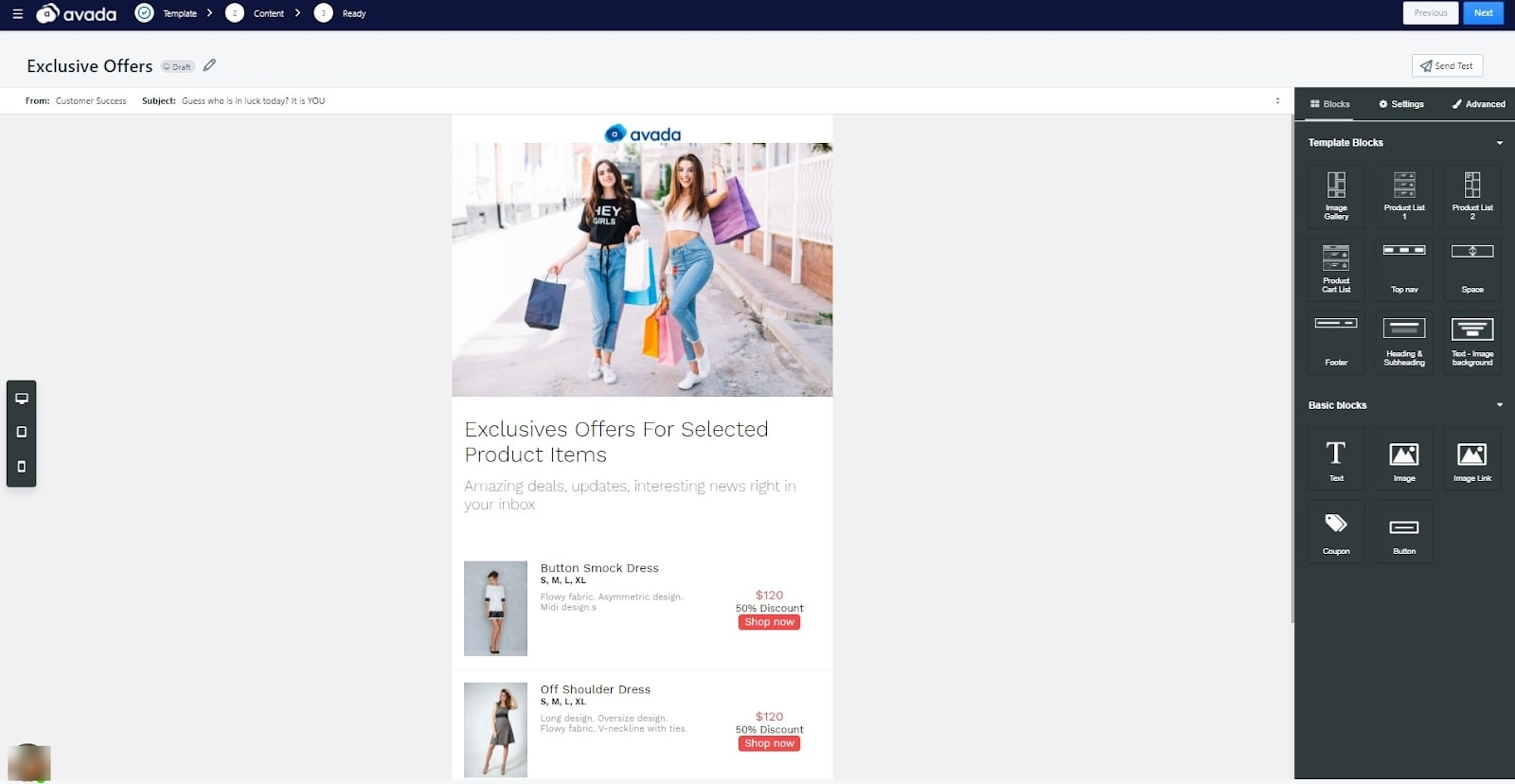
At the second step, you can edit the email’s content, remember that your subject line, design, and offer all affect the emails’ performance, not just the timing. So, take some time to perfect your email as an irresistible offer, then click on ‘Next’.
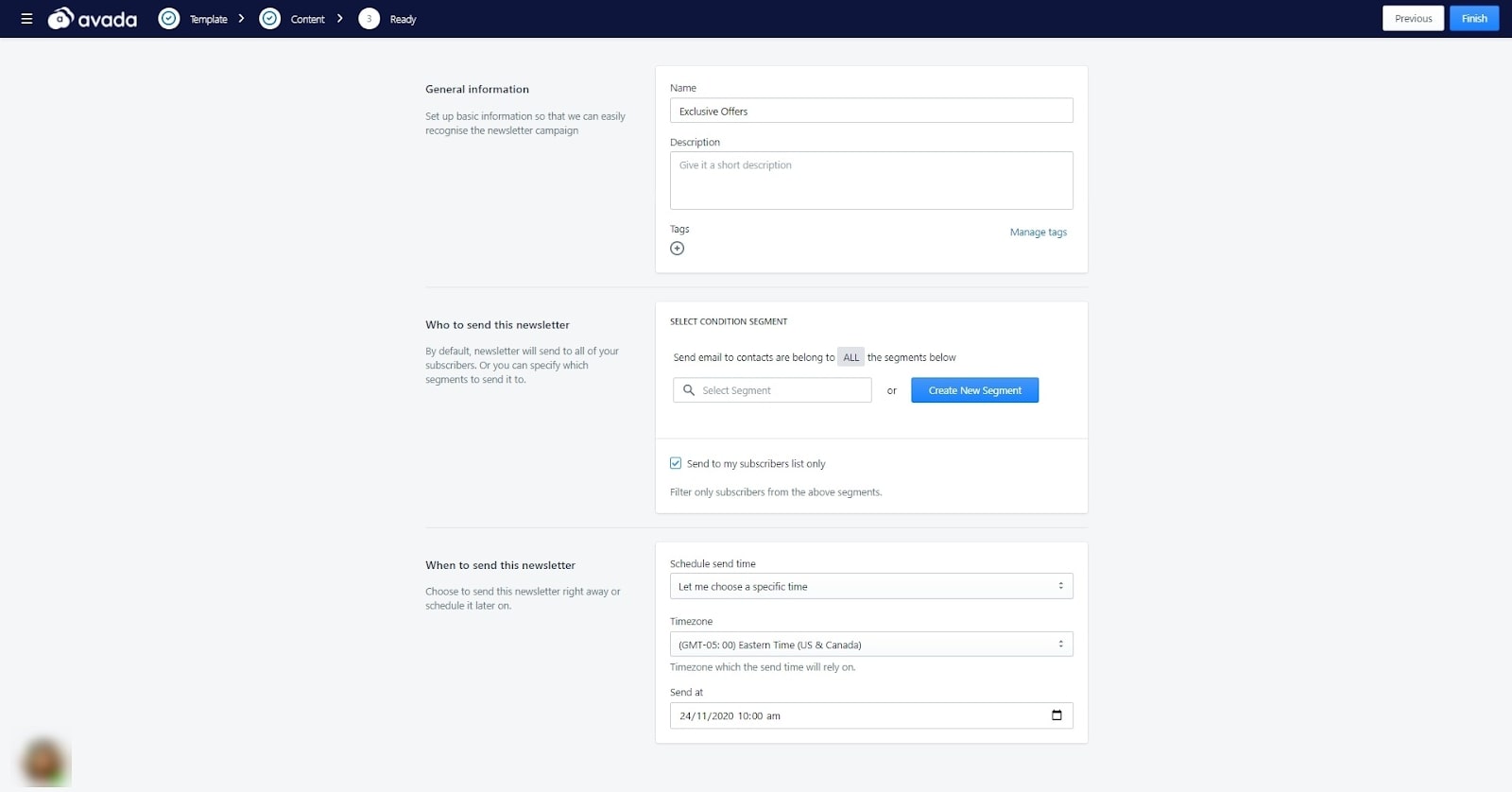
In the final step, you can edit the campaign’s general information, from name, description, to the recipients of this newsletter. As your email list combines different groups of recipients, it is a good idea to segment them and see which time fits which group better. Then, you can set when to send the campaign. Like in the picture, I set the campaign to send at 10am on Tuesday, Eastern Time.
Here, just click ‘Finish’ and your campaign will go live.
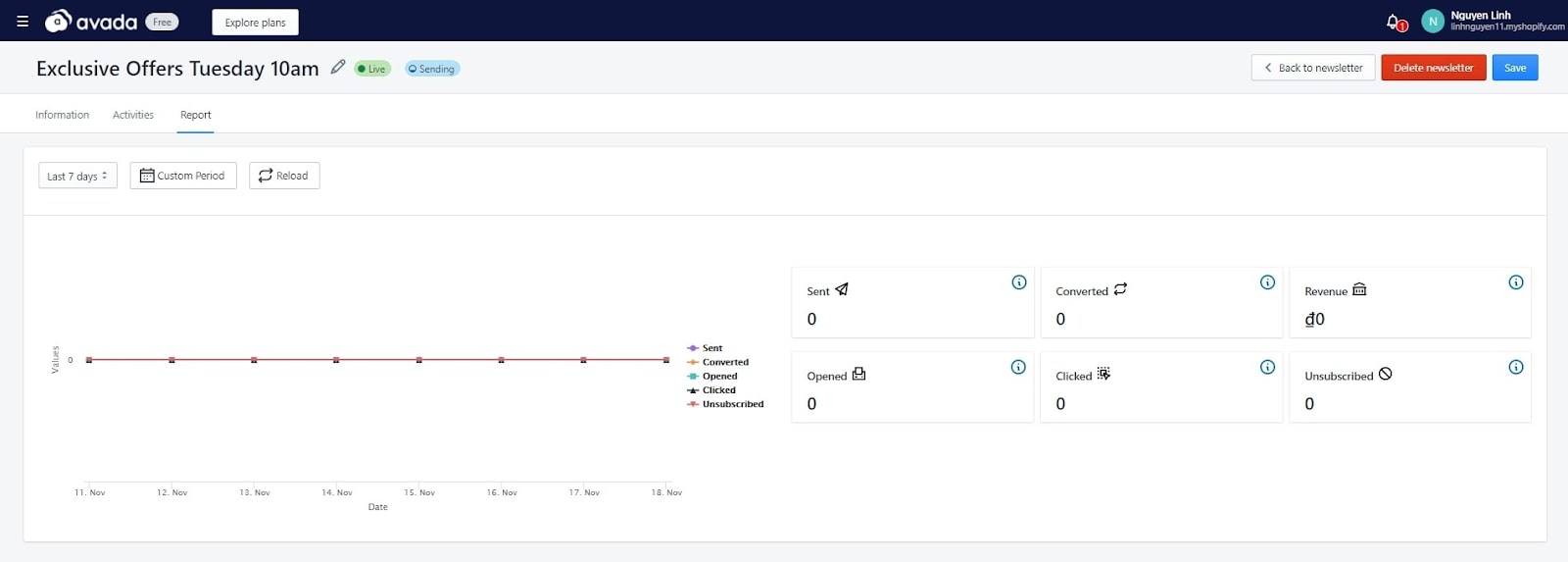
After the campaign is live, you can check the performance. You can see the statistics on sent, open rates, conversion rate, clicks, revenue, and unsubscribe rate in the report tab. This will be valuable information to find the best timing with the best results for your email campaigns. And that is how you automate your email send time to analyze and further optimize your campaigns.
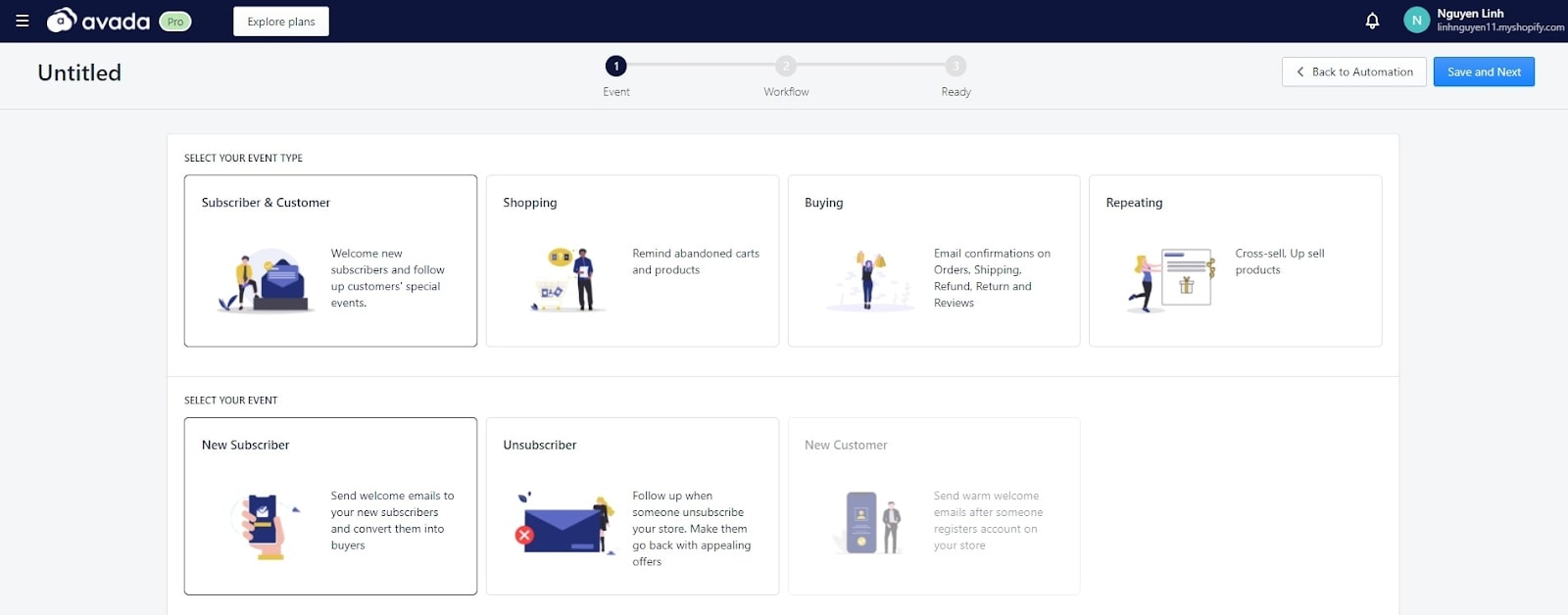
But, if you want to save time, the app also has automated campaigns for certain events like new subscribers, new orders, abandoned carts, and more. When customers perform a certain action, these automated email campaigns will be sent. You can access these features in ‘Messages’ -> ‘Automation’
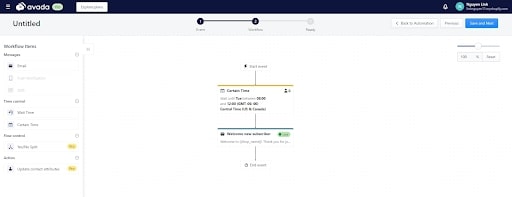
In the workflow, you can edit the certain timing of the email, making the campaign get sent at your preferred time. In the image, I’m setting may welcome new subscriber emails to be sent at 8am to 12am on Tuesday, as an example. You will be able to further test your timing with your email series in the app, so go check it out!
Some more tips on email timing for the best results
Don’t think you are done with an email campaign just with the timing. A perfectly timed email with an irrelevant message will be worthless, while an ill-timed email with a relevant offer will engage with the prospects much more. That why these are some tips to spice up your perfectly-timed campaigns even more:
- Emphasize the benefits: Always focus on what the users are getting out of the deal, not why your company needs them. Make it very clear in your message what solution, experience, and emotion they can get if they complete the action you are guiding them towards.
- Spend time on your subject lines: Subject lines are often one of the most important parts of the correspondence rate. They will get your emails opened and clicked on, or flagged as spam. Never stop adjusting and testing your subject lines.
- Showcase examples of other customers: By providing case studies from satisfied customers, you will be serving a successful lifestyle, which is what most people are interested in, rather than a simple sales pitch they get daily from other companies.
- Include a sense of urgency: A bit of urgency will make your leads act faster, but don’t ask them to make a purchasing decision on the spot. A 48-hour window is often the right amount of time for consideration.
To read more on our email guides, try these articles:
- The ultimate guide to maximize Email Marketing ROI
- How to create an email marketing campaign that highly converts
- How to improve your email click-through rate by 32%?
Final words
Finding the best time to send your marketing emails depends a lot on how well you understand your subscribers. Don’t experiment any day and time you like, try out what’s working well and improve upon that based on what I provided in this article. Get to know your audience and use the tools available to learn their habits and get in touch at the perfect time.
Have you figured the best times to send emails? Do you find a tool like AVADA Email Marketing helpful? Let me know in the comments, and thanks for reading!
New Posts






